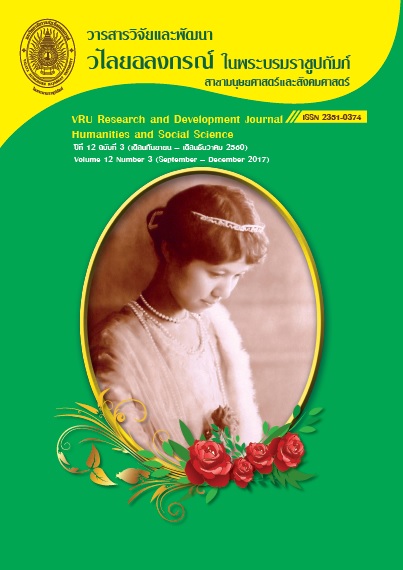การบริหารจัดการน้ำแบบมีส่วนร่วมของประชาชนที่มีประสิทธิผล ในเขตพื้นที่สำนักงานชลประทานที่ 11 กรมชลประทาน
Main Article Content
Abstract
การวิจัยนี้มีวัตถุประสงค์ 4 ประการคือ 1) เพื่อศึกษาสภาพการบริหารจัดการน้ำแบบมีส่วนร่วมของประชาชน ในเขตพื้นที่สำนักงานชลประทาน ที่ 11 2) เพื่อวิเคราะห์องค์ประกอบเชิงยืนยันของแต่ละปัจจัยคัดสรรการบริหารจัดการน้ำ ตามแบบจำลองสมการโครงสร้าง (Structural Equation Model) 3) เพื่อศึกษาความสัมพันธ์เชิงเหตุผลตามแบบจำลองสมการโครงสร้าง และ 4) เพื่อนำเสนอแนวทางที่มีประสิทธิผลสำหรับการบริหารจัดการน้ำแบบมีส่วนร่วมของประชาชน ข้อมูลที่ใช้ในการศึกษาได้มาจากแบบสอบถามประชาชนผู้ใช้น้ำ จำนวน 379 คน โดยใช้การสุ่มแบบหลายขั้นตอน และวิเคราะห์ข้อมูลโดยใช้สถิติ จำนวน ร้อยละ ค่าเฉลี่ย ส่วนเบี่ยงเบนมาตรฐาน การทดสอบค่าทีแบบ One-sample t-test การวิเคราะห์องค์ประกอบเชิงยืนยัน และ การวิเคราะห์เส้นทาง ด้วยโปรแกรม LISREL
ผลการวิจัยพบว่า 1) สภาพการบริหารจัดการน้ำแบบมีส่วนร่วมของประชาชน มีปัจจัยด้านการรับรู้ข้อมูลข่าวสาร ปัจจัยด้านกระบวนการมีส่วนร่วม และ ปัจจัยด้านประสิทธิผล อยู่ในระดับต่ำ (p< .05) 2) องค์ประกอบเชิงยืนยันของแต่ละปัจจัยคัดสรรตามแบบจำลอง เป็นไปตามข้อตกลงทางสถิติ และน้ำหนักองค์ประกอบตั้งแต่ 0.70 ขึ้นไป พบว่า องค์ประกอบทั้งหมดมีบางส่วนที่ไม่เป็นองค์ประกอบสำคัญของปัจจัยคัดสรร 3) ประสิทธิผลการบริหารจัดการน้ำตามแบบจำลอง พบว่า ได้รับอิทธิพลทางตรงมาจากปัจจัยสำคัญทั้งสามด้านในระดับต่ำคือ ด้านกระบวนการมีส่วนร่วม (Direct Effect or DE = 0.36) ด้านการรับรู้ข้อมูลข่าวสาร (DE = 0.35) และ ด้านการบริหารจัดการน้ำแบบมีส่วนร่วม (DE = 0.24) ในทำนองเดียวกันได้รับอิทธิพลทางอ้อมมาจาก ปัจจัยด้านการบริหารจัดการน้ำในระดับปานกลาง โดยส่งผ่านปัจจัยด้านการรับรู้ข้อมูลข่าวสาร และ/หรือ ปัจจัยด้านกระบวนการมีส่วนร่วม (Indirect Effect or IE = 0.67) และ ได้รับอิทธิพลทางอ้อมมาจากปัจจัยด้านการรับรู้ข้อมูลข่าวสารในระดับต่ำ โดยส่งผ่านปัจจัยด้านกระบวนการมีส่วนร่วม (IE = 0.28) โดยปัจจัยทั้งสามดังกล่าวสามารถทำนายปัจจัยประสิทธิผลการบริหารจัดการน้ำแบบมีส่วนร่วมทั้งทางตรงและทางอ้อม ได้ ร้อยละ 70.40 อย่างมีนัยสำคัญที่ระดับ .05 และ 4) มี 5 แนวทางที่เหมาะสมสำหรับการบริหารจัดการน้ำให้มีประสิทธิผล คือ 1) ด้านประชาชน มี 2 แนวทาง ได้แก่ (1) การจัดตั้งกลุ่มประชาชนผู้ใช้น้ำให้ได้ร้อยละ 100 (2) การพัฒนากลุ่มประชาชนผู้ใช้น้ำแบบก้าวหน้าให้เป็นกลุ่มบริหารจัดการน้ำ (JMC: Joint Management Committee for Irrigation) 2) ด้านการจัดการ มี 3 แนวทาง ได้แก่ (1) การพัฒนาระบบการประชาสัมพันธ์ให้มีประสิทธิภาพ (2) จัดหน่วยบริการเคลื่อนที่เร็ว และ (3) การรับฟังเสียงประชาชนในรูปแบบของการ ประชุม อบรม หรือ พบปะชุมชนเป็นระยะ รวมทั้งมีการจัดทำการวิจัยเกี่ยวกับการมีส่วนร่วมของประชาชนต่อการดำเนินงานของชลประทานปีละครั้ง
The purpose of this study was four fold: 1) to investigate the states of Water Management with Participation of People in the Regional Irrigation Office 11; 2) to analyze the confirmatory components of each selected factor (with the structural equation model); 3) to examine the causal relationship with the structural equation model; and 4) to present the effective approaches for participatory water management. Data from a set of 379 questionnaires and using multi-stage random sampling technique, were analyzed by the following statistics: frequency, percentage, mean, standard deviation, one-sample t-test, confirmatory factor analysis, and path analysis with LISREL.
It was found that: 1) The water Management with Participation of the following, namely perception of people in term of community information, participatory process, and effectiveness aspects were at a low significant level and at the .05 level; 2) Of confirmatory components of each factor with the structural equation model, these statistics were as statistical assumption agreements; 3) Effectiveness of water management received the direct effects from the 3 factors at low level, namely participatory process of people (DE = 0.36), perception of people in terms of information (DE = 0.35), and water management with participation of people. (DE = 0.24). In addition, it received an indirect effect from water management with people participation at a moderate level through the people perception in terms of information and/or water management with people participation (IE = 0.67), and finally, receiving an indirect effect from the people perception in terms of information at the low level through the participatory process of people (IE = 0.28). Those three factors could predict the effectiveness of water management with participation of people, both direct and indirect effects, at 70.40 percent and at the .05 level of significance; and 4) There were five appropriate effective approaches to ward water management with participation of people, namely 1) People aspect, 2 appropriate approaches and 2) Management aspect, 3 appropriate approaches.
Article Details
ลิขสิทธิ์บทความวิจัยที่ได้รับการตีพิมพ์เผยแพร่ในวารสารมนุษยศาสตร์และสังคมศาสตร์ วไลยอลงกรณ์ ในพระบรมราชูปถัมภ์ ถือเป็นกรรมสิทธิ์ของคณะมนุษยศาสตร์และสังคมศาสตร์ มหาวิทยาลัยราชภัฏวไลยอลงกรณ์ ในพระบรมราชูปถัมภ์ ห้ามนำข้อความทั้งหมดหรือบางส่วนไปพิมพ์ซ้ำ เว้นแต่จะได้รับอนุญาตจากมหาวิทยาลัยเป็นลายลักษณ์อักษร
ความรับผิดชอบ เนื้อหาต้นฉบับที่ปรากฏในวารสารมนุษยศาสตร์และสังคมศาสตร์ วไลยอลงกรณ์ ในพระบรมราชูปถัมภ์ เป็นความรับผิดชอบของผู้นิพนธ์บทความหรือผู้เขียนเอง ทั้งนี้ไม่รวมความผิดพลาดอันเกิดจากเทคนิคการพิมพ์

